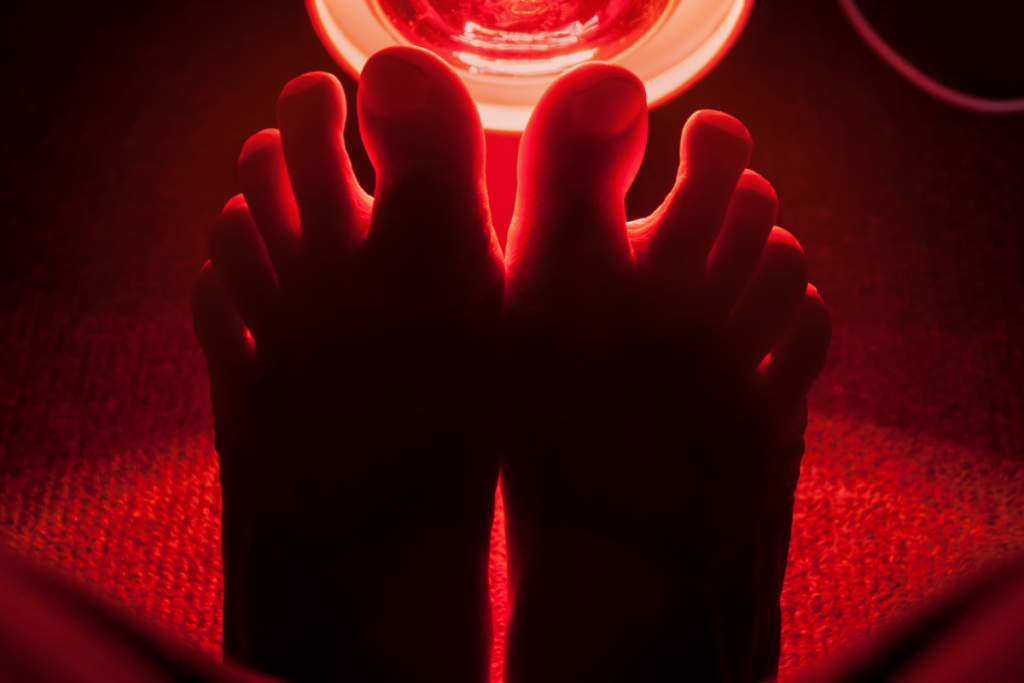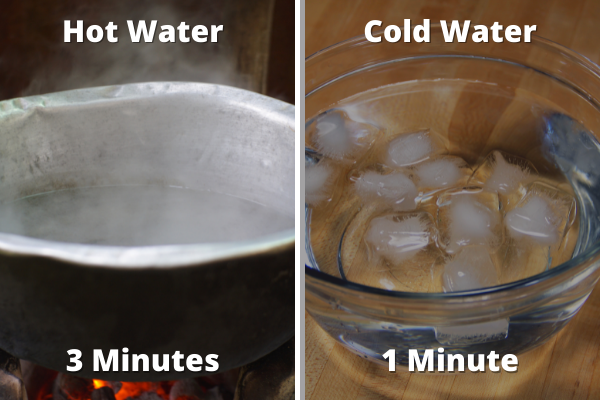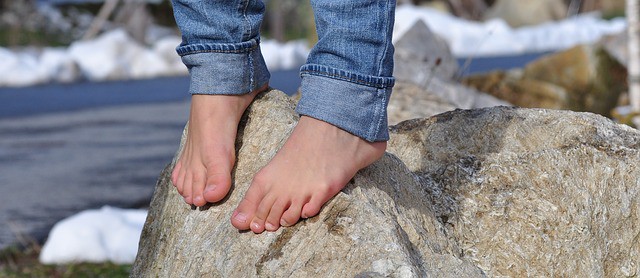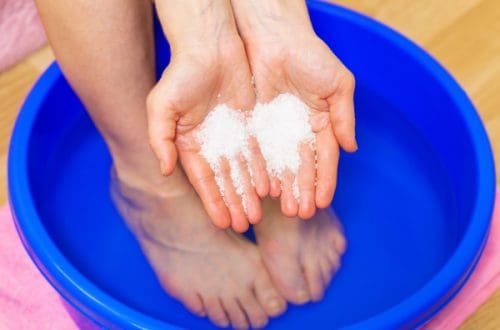Plantar fasciitis is a debilitating foot condition that can be extremely painful and last for long periods of time. It is caused by damage and inflammation to the plantar fascia tissue that runs along the base of the foot.
One of the recommended treatment methods for controlling the pain and inflammation, is cold and heat therapy.
Depending on what stage you are at with your plantar fasciitis condition, will determine whether you will benefit more from the application of hot or cold therapy.
So is it better to use hot or cold therapy on your plantar fasciitis? In the very early stages of plantar fasciitis, known as the ACUTE stage, you will benefit from ICE application. For plantar fasciitis that has lasted more than a few weeks, known as the CHRONIC stage, you will benefit from using HEAT therapy. Over time, combining BOTH methods will provide comfort and pain relief.
We will now explain in greater detail how the different application of heat and ice can benefit your plantar fasciitis recovery, and when it is best to use each method for the greatest effect.
Disclaimer: This article contains affiliate links to recommended products. We may receive a small commission on qualifying purchases, but at no extra expense to you.
When To Apply Ice to Plantar Fasciitis
The application of ice to a fresh plantar fascia injury, is most effective within the first 48 – 72 hours of the injury first occurring.
When an injury is new (acute), the application of ice will cause the blood vessels in the area to narrow and restrict blood flow. This will help reduce swelling and inflammation around the injury.
ICE THERAPY IS MOST EFFECTIVE IN THE FIRST 48 -72 HOURS OF A NEW INJURY OR PAIN SOURCE
How Often To Apply Ice to New Plantar Fasciitis Injury
Ice should be applied to the injured plantar fascia at intervals of every 2 – 4 hours during the first 48 hours of the injury occurring.
The ice should be applied for a period of 10 – 20 minutes at a time, however do not exceed 20 minutes as there are no further benefits to applying the ice for longer than this time.
If you find it uncomfortable to keep the ice in place for the full 20 mins, then you can apply it in 2 x 10 minute applications if you prefer.
After the 20 minutes, you want to allow the affected area to return to the normal temperature before applying the ice again. As mentioned, 2 – 4 hour intervals between applications is a good timeframe to follow.
How To Apply Ice to A Plantar Fascia Injury
There are many different methods to apply ice to your injured plantar fascia, and it will benefit you to find a way that feels most comfortable.
CAUTION: It is reccommended that you place something like a cloth between the ice and your skin, to prevent ‘ice burn‘
Here are a selection of different methods for applying ice to your injury:
Frozen Peas
We have probably all seen, or even done it ourselves, where a bag of frozen peas (other frozen foods are acceptable!) has been used to help prevent swelling to an injury (usually on TV after someone has been given a black eye)
This method of application is popular due to the fact you can use something that you already likely have to hand, and in the case of peas, can easily be moulded around the affected area. Wrapping the bag in a cloth or towel will probably make the it more comfortable for you.
Just ensure that you return the bag to the freezer between applications, and it is probably wise not to eat the contents when you are finished, due to the constant thawing and freezing that may have occurred. You can of course keep the used bag in the freezer marked as ‘ice pack’ for future use should you need it.
Ice Wraps
If you are a physical person who may be likely to suffer with sprains, injuries etc on a more regular basis, you may prefer to use a more dedicated ice wrap for your treatment.
Ice wraps have been designed to hold a cold pack against the injured area using straps. This allows you to potentially do other things whilst icing the injury, knowing that the ice pack will remain in place.
Some of the wraps can also be used to apply heat to the area as well as cold, which will be useful should your plantar fasciitis continue to the ‘Chronic’ stage.

Ice Socks
Unlike the wrap that can be used for many areas that have been injured, the ice socks have been made especially to deal with icing foot problems such as plantar fasciitis.
Essentially they consist of a pair of socks with pouches on the top and base of the foot for inserting the ice packs that come supplied.
The benefits of the socks allow you to comfortably apply ice to the whole base of the foot ensuring the inflamed areas are receiving the benefit of the ice application.

When Ice Treatment Should Be Avoided
Although the application of ice to the damaged plantar fascia will be beneficial in most cases, there are some exceptions.
If you have any of the following coditions/symptoms, then it is advisable that you avoid applying ice to your injury.
- If the injury site has a open wound or cut
- If you suffer from bad circulation
- If you suffer with high blood pressure
- If you have stiffness in the affected area
- If you have been given any type of anaesthesia to the affected area
- If it is a persistent / Chronic injury that you have had for a while
Hopefully the icing has been effective during the initial onset of your plantar fasciitis, and the pain and swelling has subsided.
As you are in the very first stages of plantar fasciitis, you will find that any stretching exercises you do will have the most positive outcome.
Plantar fasciitis responds better to treatment during the acute phase, and your chances for a quick and full recovery are at their highest during this time.
Following some kind of stretching exercise schedule at this point will hopefully see you back on your feet and pain free sooner rather than later.
Be sure to read our article 5 Steps to Quicker Plantar Fasciitis Recovery for further advice on healing your condition.
ICE THERAPY BECOMES LESS EFFECTIVE AFTER THE FIRST 72 HOURS OF INJURY AND HEAT THERAPY BECOMES MORE IMPORTANT
Essentially this means that is is an older injury and will require a slightly different approach to newer conditions.
When To Apply Heat To Plantar Fasciitis
If you have been suffering with your plantar fasciitis for longer than a few weeks, then you are now dealing with the CHRONIC phase of the condition.
It is during the ‘chronic phase’ of plantar fasciitis that heat therapy becomes a much more effective treatment than ice therapy.
If after several weeks of diligently doing stretching exercises to help heal your damaged plantar fascia, the pain is still in place, it may such that the condition is worse than first appeared.
It is now time to start applying heat therapy into your daily treatment plan to see if you can help to speed up your recovery.
Applying heat to the area of the damaged plantar fascia will have the opposite effect to the ice, and will actually open the surrounding blood vessels wider.
The opening of the blood vessels will increase blood flow, and in turn supply more oxygen to the affected area, which will help promote healing.
An added benefit of the heat application is the soothing and relaxing feeling that the heat provides.
How Often Should You Apply Heat To Plantar Fasciitis
Heat should be applied to the damaged plantar fascia area for 20 – 30 minute sessions. You should then allow the area to return to a normal temperature over several hours, prior to applying the heat again.
You should try to avoid heating the area for longer than 30 minutes as you may inadvertently burn the area or cause some skin sensitivity.
How To Apply Heat For Plantar Fasciitis
Applying heat to your damaged plantar fascia tissue can be done in a number of ways.
Unlike ice where you basically have to apply ‘ice’, heat can be applied through a variety of ways:
Dry Heat: This is the application of heat in a dry manner using items such as heating pads, wraps, heat lamps
Moist Heat: This is the application of heat through wet methods such as hot water baths, heating lotions, hot towels.
Here are a few of the most common ways to apply heat therapy.
Hot Water & Foot Spa
Quite simply, soaking your feet in hot water for 20 minutes will allow the blood vessels to expand and provide more oxygen to the affected areas of the feet.
This method can be as simple as grabbing a large bowl and adding hot water, or a fit for purpose foot spa.
There are many foot spa options on the market and all have a range of different features to help aid your foot recovery.
Some of the models made for plantar fasciitis sufferers also include massage bars built into the base of the machine so that you are able to gently massage the plantar fascia whilst the hot water increases blood flow.
Massaging Foot Spas Bring Soothing Relief to Painful Feet
Heat Pads & Wraps
Heat pads and wraps, work in much the same way as the ice wraps, allowing you to apply the heat directly to the affected area.
Some of the wraps are heated in the microwave and will cool down over time, whereas others are electric and will supply an constant and thermostatically controlled heat.


Heated Foot Massager
Many plantar fasciitis find beneficial pain relief from using a shiatsu style foot massager.
These massage machines have become very efficient at providing deep heat penetrating massages that benefit the whole foot.
Depending on how much you want to spend, a decent machine that will provide much pain relief, as well as helping to promote healing of the plantar fascia, can cost as little as a couple of session with a qualified foot masseuse.
If you have a job that requires you to be on your feet for much of the day, then your recovery rate is likely to be much slower than if you are seated for much of the day.
Perhaps investing in a foot massager to bring pain relief and comfort as well as promoting healing could be money well spent.
Infrared Heat Therapy
Infrared heat therapy is when a light source is used to heat up and help heal the affected area.
The light source is invisible to the naked eye but is able to penetrate deeper into the damaged tissue of the plantar fascia.

There are infrared light sources that can be purchased for home use, or alternatively you can visit an specialised practitioner that will have heavy duty equipment for deeper penetration.
Read our article about the benefits here: Infrared Therapy For Plantar Fasciitis Recovery
When Heat Treatment Should Be Avoided
Just as there are reasons for avoiding ice therapy, the same can be said for heat therapy. You want to refrain from using heat if you have any of the following:
- Infection in affected area – (can be spread through heat)
- Open wounds in the affected area
- swelling in the affected area
- Increased pain after application
If you are not seeing any improvement in your pain or condition after a few weeks of applying heat therapy, you should consult your medical practitioner for further advice.
Combining Ice & Heat Therapy
As we have mentioned, ice therapy if for new injuries and heat therapy is for older injuries.
If after several weeks of heat therapy, you feel you are just not making progress with your recovery, you may want to try ‘Contrast’ Therapy.
Contrast therapy takes the benefits of both ice and heat therapy and combines them in quick succession to try and accumulate the benefits from both.
You may have watched people on the TV doing full immersion contrast therapy without even realising it. Those crazy people that jump into an ice lake and then run to get into a steaming hot sauna are partaking in full immersion contrast therapy.
There are considered to be many benefits to this practice if you have the willpower to jump into an ice lake or bath in the first place.
How To Use Contrast Bath Therapy With Plantar Fasciitis
Although many people think of contrast therapy as being full body immersion, you can do it on a smaller scale to treat your plantar fasciitis.
Bet you’re glad I’m not suggesting you fill your bathtub with ice water and jump in!!!
No, it’s just your feet that will be taking the plunge, and that seems a little more bearable doesn’t it.
The basic process is that you have a bowl of ice water, and next to it a bowl of hot water.
The hot water should be as hot as you can tolerate without burning yourself, and the cold can be just plain cold tap water or if you prefer colder, add some ice cubes.
Contrast Bath Method
- Place your feet in the hot water bath for a total of 3 minutes. Gently stretch your feet while they soak.
- Immediately immerse your feet into the ice water for 1 minute
- Return your feet to the bath for 3 minutes
- Repeat the process for a total of 4-5 times ending on the cold bath

How The Alternating Hot & Cold Therapy Works
With the quick contracting and expanding of the blood vessels as you alternate between the two extremes, the body creates an almost pumping process that help flush through oxygen, and clear out impurities, whilst reducing inflammation and reducing pain.
It has been stated that doing it less than 3 times does not create the pumping effect, and doing it more than 6 time reduces the overall benefits of the practice and so 4-5 is about optimal.
When You Shouldn’t Use Contrast Therapy with Plantar Fasciitis
Do NOT try to do contrast therapy on a new (acute) injury as it may well have a detrimental effect, and can actually increase swelling rather than reducing it.
Contrast therapy is really something you want to try when you have already gone through the ice therapy during the acute stage, and the heat therapy during the chronic stage.
You should also avoid using contrast therapy if you suffer with any of the reasons listed for not doing the ice and heat therapy.







